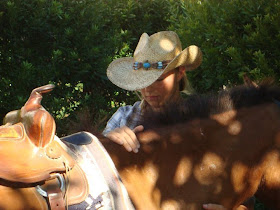

Within the next two weeks I expect that Edward Teach will have his first ride in the woods. (Search previous posts for the hisotry of this stallion who lost a serious stud fight in the wild, his recovery and his training.) He has now been handled for about 25 hours and will be easier to finish than was even Croatoan.
The pictures above are of some of my original team of bronc busters along with four wild Corollas, one of whom was being ridden for the first time in the round pen. Those little riders and I trained seven horses and one donkey well enough to be safely ridden in the woods in one summer. Of all of those horses we did not have a single buck. I do not mean that no one was bucked off. I mean that not one of the wild horses or colts ever bucked.
That is my thing. I love working wild horses with my riders. I would really love to spend more time doing so. Last week I was asked why I have not yet trained a particular horse. The catch is that I have some other things to do that take up a bit of my time. For example, in the immediate future I need to:
1. Draft scripts for two different documentaries that we are putting together on the Corollas;
2. Complete legal forms to form a non profit to handle the Corolla off site breeding program;
3. Replace many posts on our nearly two miles of fencing;
4. Dig three more water holes;
5. Lime and weed and cut nearly 20 acres of pasture;
6. Sell several non-Corollas;
7. Write a magazine article on the off site breeding program;
8. Complete the last on line classes on how we raise and train horses;
9. Host a tour of local tourism and business leaders to show them what goes on in our woods;
10 Continue to ride Tradewind enough miles to ensure national recognition for this formerly wild, formerly crippled stallion;
11 Complete the training of Swimmer, Valor and Persa, three formerly wild horses that will be primarily my saddle horses (as opposed to being used by student riders);
12 Polish Standing Holy until she responds perfectly to my cues;
13 Get our training video viewing program up and running for the summer;
14 Get the music program up and going again;
15 Train Stands With a Fist, Skyco and Bear Coat Miles to the degree that they can hit the woods hard and steady;
16 Feed up, water and care for the herd; and
17 Prosecute crimes by and against kids, domestic crimes and sexual assaults.
With all of that said, I am very excited about one of the things that we will begin to work on soon. Kaitlynn was my first rider to adopt a Corolla. Her filly, Matoaka, is old enough to train to saddle. This will be fun. She will be coming to stay with us for part of the summer and she will be our next little super Corolla to train.
Matoaka, Skyco, Bear Coat, Stands With a Fist, Swimmer, Edward Teach, Looks Up, Valor, and all of my little riders are what makes it worth the trouble. Just wish that I had a little more time to get things done. The unfortunate reality is that my best option is to sleep less.


















